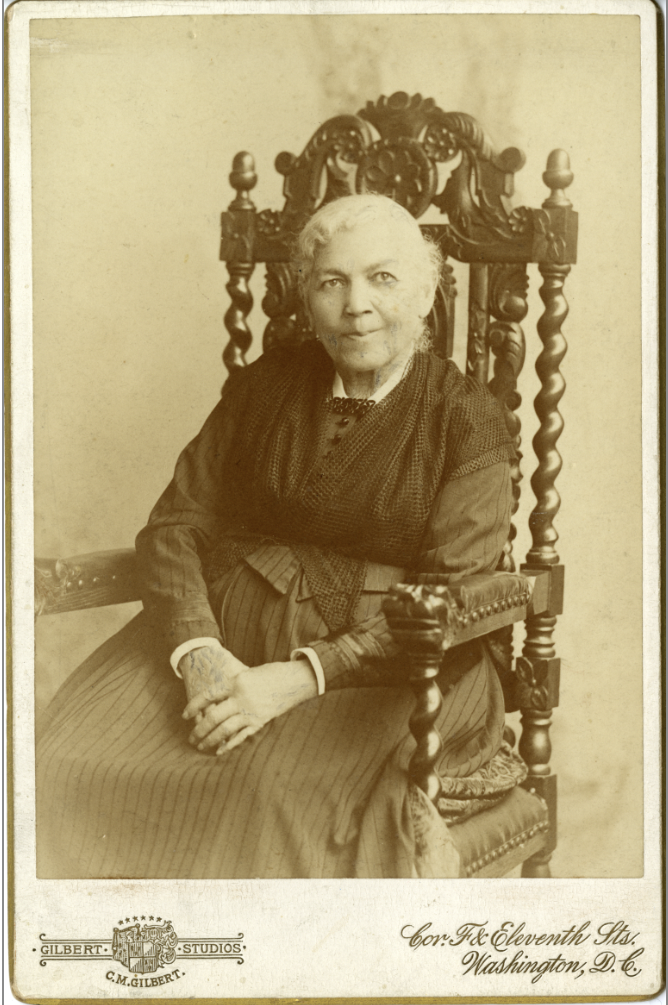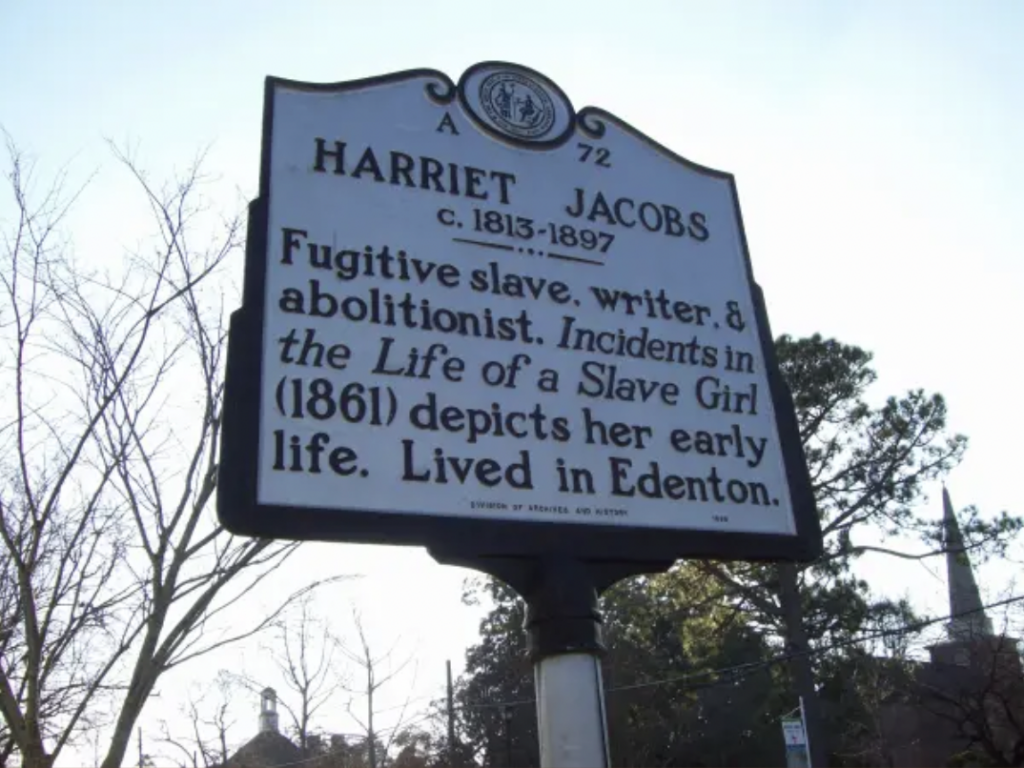“Reader, be assured this narrative is no fiction. I am aware that some of my adventures may seem incredible; but they are, nevertheless, strictly true. I have not exaggerated the wrongs inflicted by Slavery; on the contrary, my descriptions fall far short of the facts.“
(Jacobs 1861 Preface)
Under the pseudonym ‘Linda Brent’, Harriet Jacobs (1813-1897) wrote an autobiography documenting her horrific life with all injustices she had to face starting at a young age. Sexual abuse, extreme cruelty and exploitation forced her into hiding in a parochial attic for seven years until she was able to travel North.

https://www.journalofthecivilwarera.org/2019/07/harriet-jacobs-working-for-freedpeople-in-civil-war-alexandria/
Her life is divided into four main phases: enslavement, hiding, traveling and eventually freedom, where she successfully publishes ‘Incidents in the Life of a Slave Girl’ in 1861.
In ILSG, Brent describes her circumstances growing up in Edenton, which are very similar to many other enslaved African American women. In comparison to other enslaved women during that period, Brent was one of the few who survived this tragic time in American history and was able not just to achieve her and her children’s freedom, but “she made her life representative of the struggle for liberation” (Yellin 2004).
Having lost her mother at age six and her caring mistress at twelve, her life turned around to the worst, experiencing abuse from her new home. When she got pregnant twice by another man from her town, she was sent to a Plantation. After being enslaved for 22 years, she escapes from the Plantation, leading her into hiding. After seven years and a little help from her friends, she gets on a boat to Philadelphia escaping the South. Later on, in New York, she becomes a nursemaid for the Bruce family, who take her to England and eventually, after the Fugitive Slave Law made Brent’s life harder as slaves need to get reunited with their legal owners even when they are in a free State (Manfra 2008), Mrs. Bruce purchases Brent for the good making her free.The book took a great interest in developing female and minority writers. “Little did she know that she would not only testify about slavery’s horrors based on her own life, but she would also participate in finding solutions for other newly emancipated people” (Whitacre 2019).

https://americanhistory4travelers.com/2011/07/17/edenton-north-carolina-an-historic-town/
Linda Brent struggles to achieve the goals of
”True Womanhood“ which have been denied to her due to her life in enslavement and during her journey out of it. To achieve those ideals is part of her quest for freedom.
Linda Brent is for the most time of her life an enslaved person and additionally a person of color which makes her achieving the ideals of “True Womanhood” impossible, since those are reserved for white-middle-class-women. “Black woman, especially slaves in the South, usually had no chance to acquire it all” (Schulze 2009). Nevertheless Brent is constantly trying to fulfill the requirements because she connects this with her personal freedom.
One of the most important aspects of the concept of “True Womanhood” is purity. At a fairly young age, Brent gets confronted with troubles surrounding this aspect. Her master, Dr. Flint, desires a physical relationship with her but she denies his request. After numerous failed attempts, Flint offers “to make a lady out of [her]” (Jacobs 82), offering Brent an opportunity to escape slavery. Following her “pure principles” (83), she denies this offer, too. She envies those women who are free to choose their partners and whose purity has been protected. The circumstances and influences resulting of her enslavement forced her to enter a sexual relationship with another man. “I was struggling alone in the powerful grasp of the demon Slavery; and the monster proved too strong for me” (84). Her two children are a result of this relationship and proof of her defeat in this aspect, filling her with shame and regret.
Another important aspect is the concept of separate spheres. During her travels, there are multiple occasions where this concept is challenged. During her trip to New York, Brent is not allowed to travel in a first class wagon as they are reserved for white people. Instead, she is transported in “a large, rough car” (248) which was “crowded with people” (248). In those wagons, smoking and drinking is allowed and men as well as women and children are staying side by side. Separate spheres are not being established. Brent describes this part of her travel as “a very disagreeable ride” (248). “Her experience in the North is mostly rife with racial segregation and humiliation” (Biswas 2015). Multiple occasions follow in which Brent is treated in regard to her skin color and thereby differently compared to white women. The discrimination she experiences limits her possibilities for achieving the goals of “True Womanhood”. Furthermore she is limited in her personal freedom because of that. It has to be mentioned, that the discrimination Brent faces is not just because of her skin color but additionally, because she is an enslaved person. Later on, Brent visits England. “The English people, never having experienced institution of slavery, treat her based on her position, not the colour of her skin” (Biswas 2015). It is the first time Brent is confronted with “pure, unadulterated freedom” (275) which is her ultimate goal. She describes this as an extremely relieving event which proves that overcoming racial discrimination is a step towards her definition of freedom. “Her history as a slave does not follow her around in England” (Biswas 2015), so Brent feels more free than ever.
As a consequence of her escape, Brent disregards the ideals of domesticity and submissiveness inevitably. After her escape, her “family” searches for her, especially Dr. Flint, and asks her to return to them. “We all sympathize with you in your unfortunate condition, and are ready to do all in our power to make you contented and happy.” (258) states one letter addressed to Brent. The same letter claims that Brent should return to her “family” because according to them she was free the whole time and never treated as an enslaved person. Despite the wish of the family she does not return.
In the end, Brent considers herself and both of her children as free. „We are as free from the power of slaveholders as are the white people of the north“ (302). She achieved her freedom not through marriage. Brent freed herself from her life in enslavement and discrimination, trying to compete with ideals which are almost exclusively connected to white-middle-class-women. Regardless of that Brent still has not reached her ultimate goal. „The dream of my life is not yet realized“ (302). She hopes for a better future for her children, a future with complete equality and therefore a future without slavery.

https://americanhistory4travelers.com/2011/07/17/edenton-north-carolina-an-historic-town/
Bibliography
Jacobs, Harriet (1861): Incidents in the Life of a Slave Girl. Clydesdale Classics.
Secondary Sources
Biswas, Swagata. „Reading Race, Class and Gender in Harriet Jacob’s Incidents in the Life of a Slave Girl“. International Journal of English Language, Literature and Humanities, Vol.3, No.2, 2015, http://ijellh.com/wpcontent/uploads/2015/07/62.pdf
→ discrimination in ILSG
Manfra, Meghan M. A Teacher’s Guide to the Signet Classics Edition of Harriet Jacob’s Incidents in the Life of a Slave Girl. North Carolina State University. Penguin Group, 2008.
→ character list, synopsis, historical setting, biography of Jacobs
Schulze, Daniela. Harriet Jacobs – Incidents in the Life of a Slave Girl. The Question of True Womanhood – Gender and Race Conventions. München, GRIN Verlag, 2009.
→ true womanhood in ILSG
Whitacre, Paula Tarnapol. „Harriet Jacobs: Working for Freedpeople in Civil War Alexandria“. Journal of the Civil War Era, 16 July 2019, https://www.journalofthecivilwarera.org/2019/07/harriet-jacobs-working-for-freedpeople-in-civil-war-alexandria/
Yellin, Jean Fagan. Harriet Jacobs. A Life. The Remarkable Adventures of the Woman Who Wrote Incidents in the Life of a Slave Girl. Basic Civitas Books, 2004.
→ interpretation of Jacobs’ public and private life